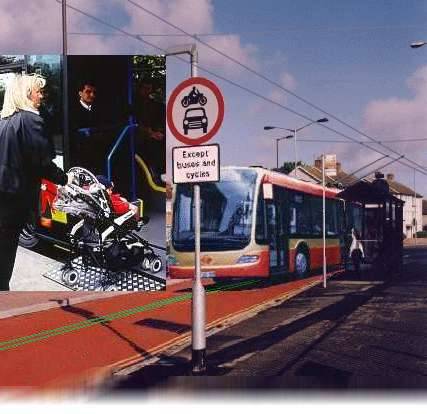
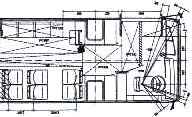
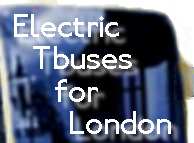

 |
   |
|
In environmental terms, whatever the power source, the Tbus is clearly the cleanest public service vehicle available.
The environmental advantages of electric vehicles are - |
Tbuses are the only way to go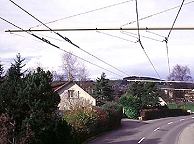 Introduction Design Guidance Overhead Financial Engineering Planning Regulation Routes Proposal Industry Download this website (868k zip file) Campaigning for quiet, clean urban transport using Overhead Electric, Zero Emission Buses - email The Electric Tbus Group |
||||
|
1. Zero emissions in the streets |
|||||
|
2. Lowest possible noise levels |
|||||
|
3. Lowest possible emissions into the environment as a whole |
|||||
|
4. Lowest possible consumption of non renewable resources |
|||||
|
5. Lowest possible release of ‘green house’ gases like CO2 |
|||||
|
Advantages 3, 4 and 5 are due to power stations supplying electricity and offering the following environmental advantages over large numbers of internal combustion engines - | |||||
|
a) Much higher conversation efficiencies - hence less fuel consumption and less CO2 production - in large fixed plant operating under stable conditions than small mobile plants operating under continually varying conditions |
|||||
|
b) Ability to control emissions like CO, NOx, SOx, HCs or particulates, more readily in large fixed plant operating under stable conditions than small mobile plants operating under continually varying conditions |
|||||
|
c) Ability to use energy resources that are otherwise impractical or impossible in vehicles e.g. like wind and water power or waste and biomass fuels |
|||||
|
Batteries.
If developments in storage battery technology produce batteries that can compete in terms of size, weight, cost, ease of recharging and efficiency, with say, a tank for diesel fuel, then all vehicles could be electric, with all the environmental advantages that would bring. But this is very unlikely to happen in the foreseeable future and the only generally practicable system for getting electric power to moving vehicles is via an energy conductor system.
Fuel cells. Fuel cells represent a halfway house between storage batteries and fuel burning engines. A fuel cell takes in hydrogen plus oxygen from the air and combines the two, producing electricity plus water as the byproduct. If supplied with hydrogen, the fuel cell can be viewed as a storage battery, but a not very efficient and a very expensive one. There are problems of distributing the hydrogen to and storing it on vehicles. If the fuel cell is supplied with a hydrocarbon fuel e.g. petrol or diesel fuel, hydrogen can be made from the fuel [by on board ‘reforming’], but this system produces much the same range of byproducts as an internal combustion engine. The prospect that on-board fuel cells will provide efficient, clean, cheap, safe power in moving vehicles is very new and very experimental. The prospects for larger and stationary fuel cells, fed [via a reformer] with natural gas, probably as part of combined heat and power schemes are very much better. Such fuel cells may provide much clean cheap electricity for electric vehicles. Fuel cells supplied with hydrogen produced by renewable sources, hold the promise of pollution free power, would require massive new infrastructures. Tbuses. Where vehicles operate a fixed route at sufficient frequency, it is both practicable and economic to provide an energy conductor system. Thus in many railway, and virtually all light systems, electric propulsion via an energy conductor, a conductor rail or trolley wire' is the norm.The same could and should be true for many of the intensive / guided bus routes envisaged in the 1999 Government consultation document, From Workhorse to Thoroughbred:A Better Role for Bus Travel As is the case with trams, objections have occasionally been voiced about the visual intrusiveness of overhead wires. Consider that the diesel bus generates 41 different substances listed as Toxic Air Contaminants, and these are released directly into the streets where pedestrians, transport users and people in other vehicles breathe them in. Given that the trolleybus eliminates these hazardous emissions, overhead wires may be seen as a symbol for clean air. They also present a sign of service permanence appreciated by passengers. Thus there would seem to be a very good case, in environmental terms, for actively encouraging the re-establishment of trolleybus systems in the UK. To give some figures, based on North American experience, comparative emissions for the latest technology diesel and tbuses [expressed in grams of pollutant emitted per vehicle kilometre driven] are: Comparative Toxic Air Contaminants based on the CBD duty cycle (in g/km) |
 |
||||
|
|
Particulates |
NOx |
CO |
||
|
Diesel |
1.3-3.5 |
22.0-38.0 |
10.0-30.0 |
||
|
'Clean' Diesel |
0.1-0.35 |
10.75-21.0 |
3.1-24.3 |
||
|
Natural Gas |
0.016-0.051 |
3.60-13.0 |
5.63-6.0 |
||
|
Diesel/Electric Hybrid |
0.017-0.23 |
6.64-8.6 |
0.08-2.5 |
||
|
Tbus (grid mix) |
0-0.2 |
2.91-3.69 |
0.056-0.144 |
||
|
Tbus (gas-fired plant) |
0 |
1.98-3.12 |
0.04-0.06 |
||
|
Tbus (hydro-electric) |
0 |
0 |
0 |
||
|
Tbus (renewables) |
0 |
0 |
0 |
||
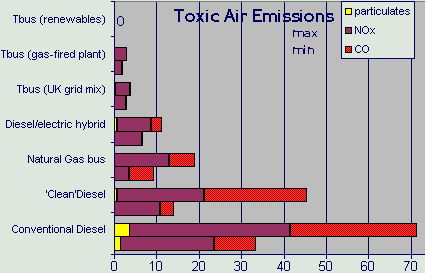 Compiled by Kevin Brown (University of Alberta/Edmonton Transit System Advisory Board) using data sourced from: Northeast Advanced Vehicle Consortium, U.S. Office of Transportation Technologies, U.S. Environmental Protection Association, BC TransLink, Edmonton Transit System, Edmonton Power, EPCOR, San Francisco Municipal Railway.
Compiled by Kevin Brown (University of Alberta/Edmonton Transit System Advisory Board) using data sourced from: Northeast Advanced Vehicle Consortium, U.S. Office of Transportation Technologies, U.S. Environmental Protection Association, BC TransLink, Edmonton Transit System, Edmonton Power, EPCOR, San Francisco Municipal Railway.
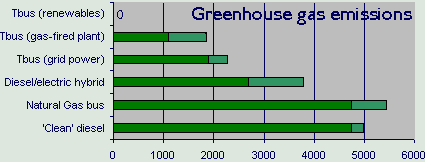 Approximate total greenhouse gas emissions based on New York City duty cycle (includes CO2, NOx, CH4, NMHC and CO) in g/km of CO2 equivalent Compiled by Kevin Brown (University of Alberta/Edmonton Transit System Advisory Board) using data sourced from: Northeast Advanced Vehicle Consortium, Edmonton Power, San Francisco Municipal Railway. Energy Efficiency. Experience has shown that tbuses are also nearly three times as energy efficient as diesel buses. Much of this efficiency stems from the higher productivity of tbuses, carrying twice as many passengers (Vancouver), usually on high density routes. There is also a marked passenger preference for tbuses. | |||||
|
|
|
|
MJ/vehicle/km |
|
|
|
|
|
Diesel bus |
24.1 |
|
|
|
Trolleybus |
9.84 |
|
|||
| source - BC Transit 1994 | |||||
|
Noise levels Tbuses, because noise is measured on a logarithmic scale, are around 175 times quieter than diesel buses. | |||||
|
|
|
hearing loss |
90+ |
90+ |
|
|
|
|
Diesel bus |
80-90 |
90+ |
|
|
CNG bus |
±75 |
90+ |
|||
|
|
|
Fuel cell bus |
<70 |
90+ |
|
|
|
|
Tbus |
50-60 |
90+ |
|
|
|
|
quiet street |
60 |
90+ |
|
| source: adapted from Coast Mountain Bus Company, Seattle Metro | |||||
|
In environmental terms, what ever the power source, the gas emissions, the efficency criteria or the noise levels, the trolleybus is clearly the cleanest public service vehicle available. email our technical / environmental / engineering query service -Eur Ing Irvine Bell BSc CEng MIMechE CDipAF PGCE |
|||||